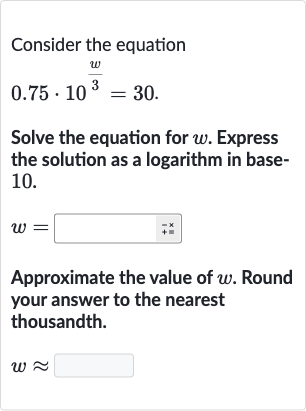Full solution
Q. Consider the equationSolve the equation for . Express the solution as a logarithm in base.Approximate the value of . Round your answer to the nearest thousandth.
- Write Equation, Isolate Exponential Term: Write down the given equation and isolate the exponential term.Given equation: To isolate the exponential term, divide both sides by :
- Simplify Right Side: Simplify the right side of the equation.So, the equation becomes:
- Apply Logarithm, Solve for : Apply the logarithm to both sides of the equation to solve for . We use the base logarithm because our exponential base is .
- Multiply by : Use the property of logarithms that .
Since is , the equation simplifies to: - Calculate : Multiply both sides by to solve for .
- Round to Nearest Thousandth: Calculate the value of using a calculator. (using a calculator for )
- Round to Nearest Thousandth: Calculate the value of using a calculator. (using a calculator for )Round the value of to the nearest thousandth.
More problems from Compare linear, exponential, and quadratic growth
QuestionGet tutor help
QuestionGet tutor help
QuestionGet tutor help
QuestionGet tutor help
QuestionGet tutor help
QuestionGet tutor help
QuestionGet tutor help
QuestionGet tutor help
QuestionGet tutor help

